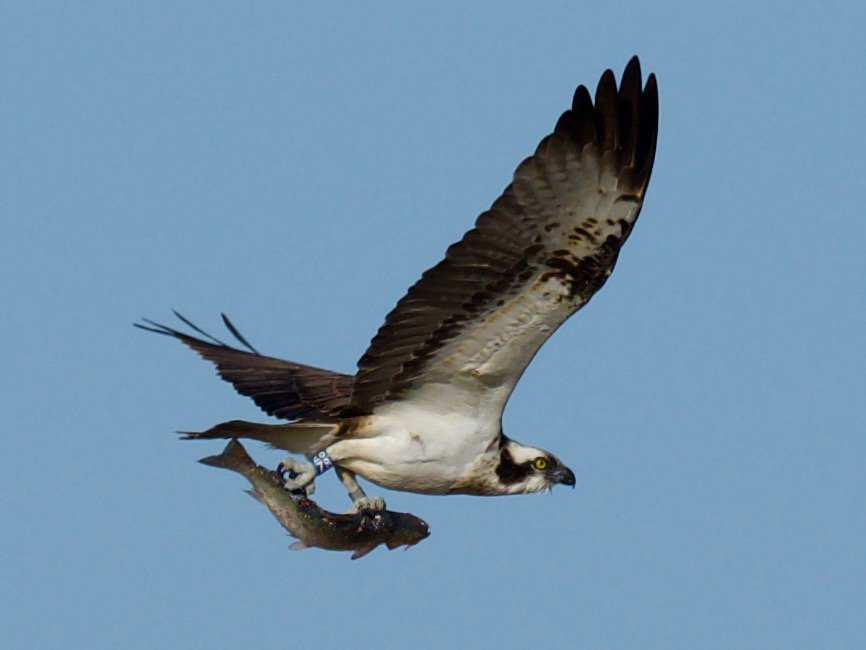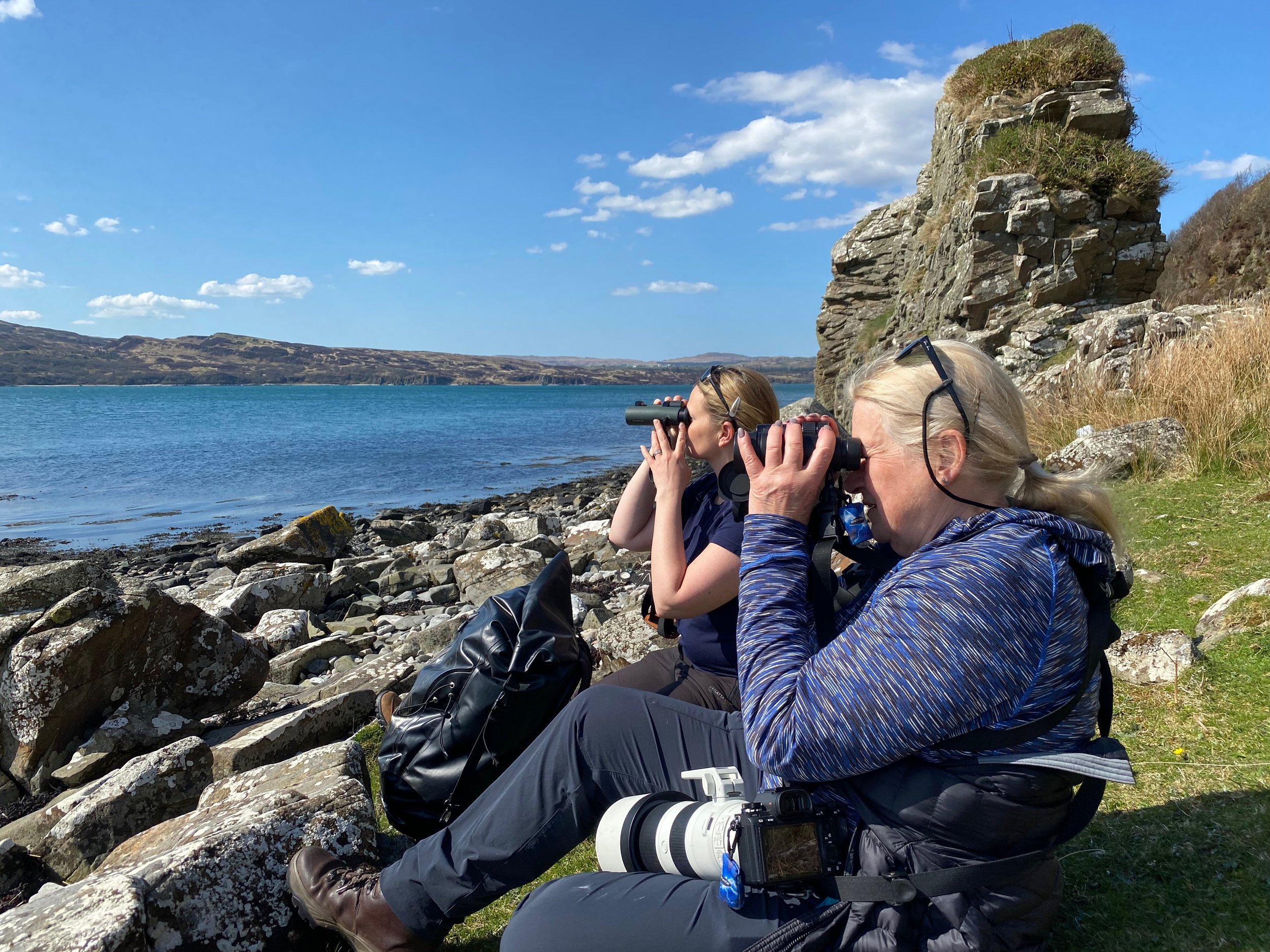Islay – In search of the Sky Dancers
A Swallow, resplendent in its glossy midnight-blue, tan-red and cream skims low over the lush wet meadow peppered with Daisy’s and Marsh Marigolds. Its course takes it up to and over a small herd of grazing Greenland White-fronted Geese, and with the beat of a wing Africa meets the Arctic.
Many places hold a charm but the islands of Islay and Jura exude it year round. They throng with life from those species that remain year-round such as Golden Eagles and Otters to the species that pulse through on their journeys north, south and those whose destinations are these Hebrides. Exposed to the full force of the Atlantic the islands are elemental in the character, sometimes raw, always changing but also frequently tranquil and soothing.
Atlantic rollers crash in on the coast at Saligo Bay, Islay
In the many years that we have visited Islay for work and play we have never been disappointed; this April was to be no exception. Starting over the Easter weekend we ran a hugely successful week-long tour to Islay and Jura. The primary focus was to find and enjoy the remarkable rollercoaster display of the Hen Harrier known as skydancing but we also hoped to enjoy the full spectrum of other species that the islands are home to or provide a much-needed stop over for during Spring.
April on Islay clutches at the last vestiges of winter whilst simultaneously welcoming the harbingers of summer. Over seven days we watched and enjoyed as migrants arrived from the south, departed to the north and established territories for the summer. Chiffchaffs, Willow Warblers and Blackcaps all sang through the scrub and woodlands, their notes adding to an orchestra of song from resident species such as Blackbird, Song Thrush, Goldfinch and Linnet. Our focus drew us to the mauve and tan landscapes of the peatlands. Here we encountered the endearing Twite, cocky Stonechat and rather dapper Whinchat but our gaze was held by the grey ghost; the male Hen Harrier.
A pair of Wheatears freshly arrived from the Sahara
Islay boasts the single best population of this enigmatic species in the UK with an estimated 40 pairs on the island. It is likely that this represents its carrying capacity for the species and every year and healthy number of new recruits are produced which disperse out across Scotland and the rest of the UK (where they are faring significantly worse under pressure from humans). It is without a doubt one of, if not the most stunning of British raptors. Svelte and smart in appearance, the males ink black wingtips contrast with ghostly white underparts and a soft-grey upperparts only topped off by a stunning blue-grey head and blazing yellow eye. To say these birds are smart is an understatement. The females are significantly more subtle. Browns, tans and greys ensure she blends in with their preferred habitat perfectly, often it is just her white rump band that gives her presence away.
View of Hen Harriers were at times sensational
The density of harriers on Islay and Jura ensures the males need to compete for females and during our week-long tour we were privileged to witness the males skydancing. This aerial display is dynamic, aerobatic and exudes an almost Mediterranean flare to it. The males power almost vertically up into the sky and right at the top of their ascent they flip onto their backs before plummeting back earthward at break-neck speed only to put the handbrake on and catapult themselves back upwards from the bottom of the dive. This dynamic display is accompanied by the high-pitched kek-kek-kek call adding to the overall ambience of the experience.
If this isn’t enough to grab the attention of a would-be mate then a food offering can sometimes seal the deal and we watched as a male arrived with its prey, most likely a Meadow Pipit and endeavoured to present this to a female but the eagerness wasn’t reciprocated. Thankfully a second female close by proved a more willing recipient and in a graceful motion she twisted upside down, talon to talon with the male and taking the prey item into her own clutch before they both slinked off out of sight. Over and over again we were treated to views of Hen Harriers, in fact over the course of the week we notched up an incredible 55 encounters, simply superb.
Look at that eye - undoubtedly the UK’s most stunning raptor
Hen Harriers aren’t the only raptors that make the islands their home. Seacliffs and areas of wilderness offer ideal habitats for eagles to breed and we were treated to ten encounters with Golden Eagles and an astonishing 39 White-tailed Eagle encounters. The latter are truly succeeding again in areas where they once flourished many years ago. Areas such as Loch Gruinart are now important feeding grounds for young birds without territories and we watched a trio of birds picking away at Barnacle Geese carcasses amongst other things. We also stumbled across the most monumental nest complete with female White-tailed Eagle tending to an unseen brood. We estimated it was 1.5m across and at least 1m deep!
An immature White-tailed Eagle cruises right over our heads
Wherever prey abundance is good there should be proportional numbers of predators so it was no surprise that five Merlins and five Peregrines whizzed by in their pursuit of a meal. Another sign of changing times was five brilliant observations of Ospreys, a species that is once again returning to lost breeding areas though is yet to colonise Islay and Jura; it must surely only be a matter of time now. Any encounter with an Osprey is great one and one of ours was particularly special. In a low late-afternoon sun we watched one individual foraging over the outer estuary at RSPB Loch Gruinart. After pausing and hovering, it plunged into the channel successfully catching a large Grey Mullet. The Osprey headed for the shore to devour its meals and as it flew close by us we noticed a blue ring adorning its right leg. Zooming in on the images we quickly acquired we could read the two digit code 'Z8'. Dan had met Z8 before, but not for five years. He is a male ringed on the 1st July 2017 at Glaslyn, Porthmadog in North Wales by the Bywyd Gwyllt Glaslyn Wildlife - Glaslyn project. On 9th September 2017 he commenced his journey south and no one had seen him since, until he appeared next to us on Islay. Where has he been and what has he been up to? Young males like this tend to spend the first few years of their life in wintering grounds, for instance along the West African coast. They typically then return to their natal area with a view to establishing a territory somewhere close by, so for him to be 200km north of his birthplace at this age is quite unusual.
Z8 and Dan’s connection goes back to Wales. Both share the same natal area and whilst back 'home' in 2017 Dan had paid a visit to the Glaslyn Osprey Project where the heads of three chicks, including Z8, were just visible above the nest rim! Little did they know they would see each other again five years later and 200km north having both explored many different areas of the world! We wonder where Z8 is now and where his path will take him.
Z8 with his Grey Mullet
Of course a week on Islay and Jura in Spring wouldn’t be complete without enjoying a few of the invertebrates on offer too. The exposed sand dunes on Islay are home to a very rare moth, the Belted Beauty. The flightless females scale fence posts where they can broadcast their pheromones to entice the winged males to them. They are round, very fuzzy and banded, some would say ‘belted’ in appearance. The males are equally furred and have an almost marbled pattern on the wings. As well as these furry little finds our explorations revealed the beautifully bejewelled Green Hairstreak butterflies, caterpillars of the nationally rare Marsh Fritillary and our moth trap also caught an immigrant from Spain, the Dark Sword Grass moth.
Female (left) and male (right) Belted Beauties
The onset of Spring is particularly noticeable around the wetlands and especially at dusk. Where they were silent just a month ago the marshes and bogs now ring with the sound of bird song. From the insect like Grasshopper Warbler song to the high-pitched squeals of Water Rails life floods back into the reeds and rushes. Sedge Warblers and Reed Buntings provide the harmonics whilst the less melodic Curlew, Lapwing, Redshank and Snipe cut through the air to create a cacophony of bird sound. Closing ones eyes amplifies the audial extravaganza but opening them adds an extra layer as mist whisps its way across the open ground and the pastel colours of dusk sink beneath the horizon. If you’ve never experienced the dusk chorus of wetlands then we thoroughly recommend you give it a go.
Nearly a full week of perfect sunsets and an amazing dusk chorus of marsh birds
Our week on these remarkable islands was yet another trip full to the brim with exciting wildlife encounters. There really is no better place in Scotland for year-round high-quality wildlife action but visiting in April provided a true sense of just how important the islands are as a crossroad for species coming and going to everywhere from Arctic Canada to Southern Africa.









